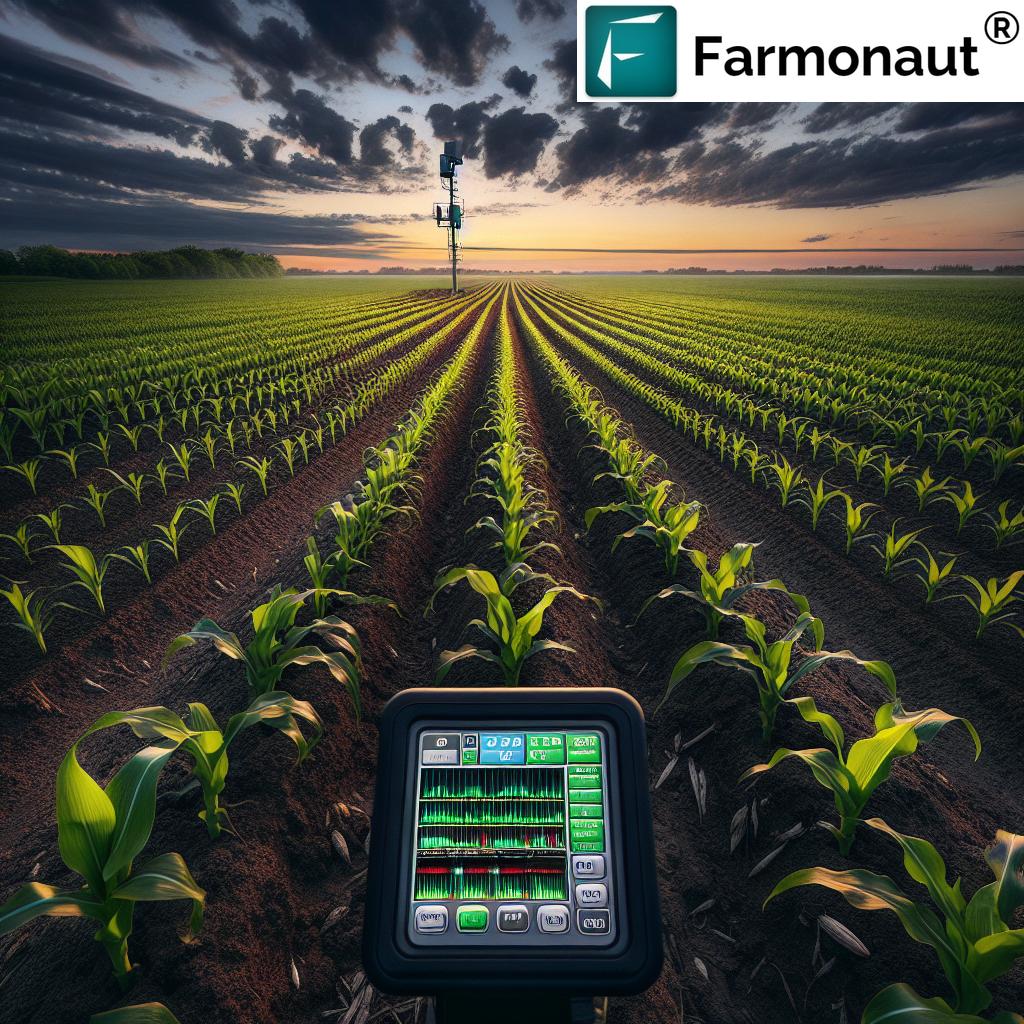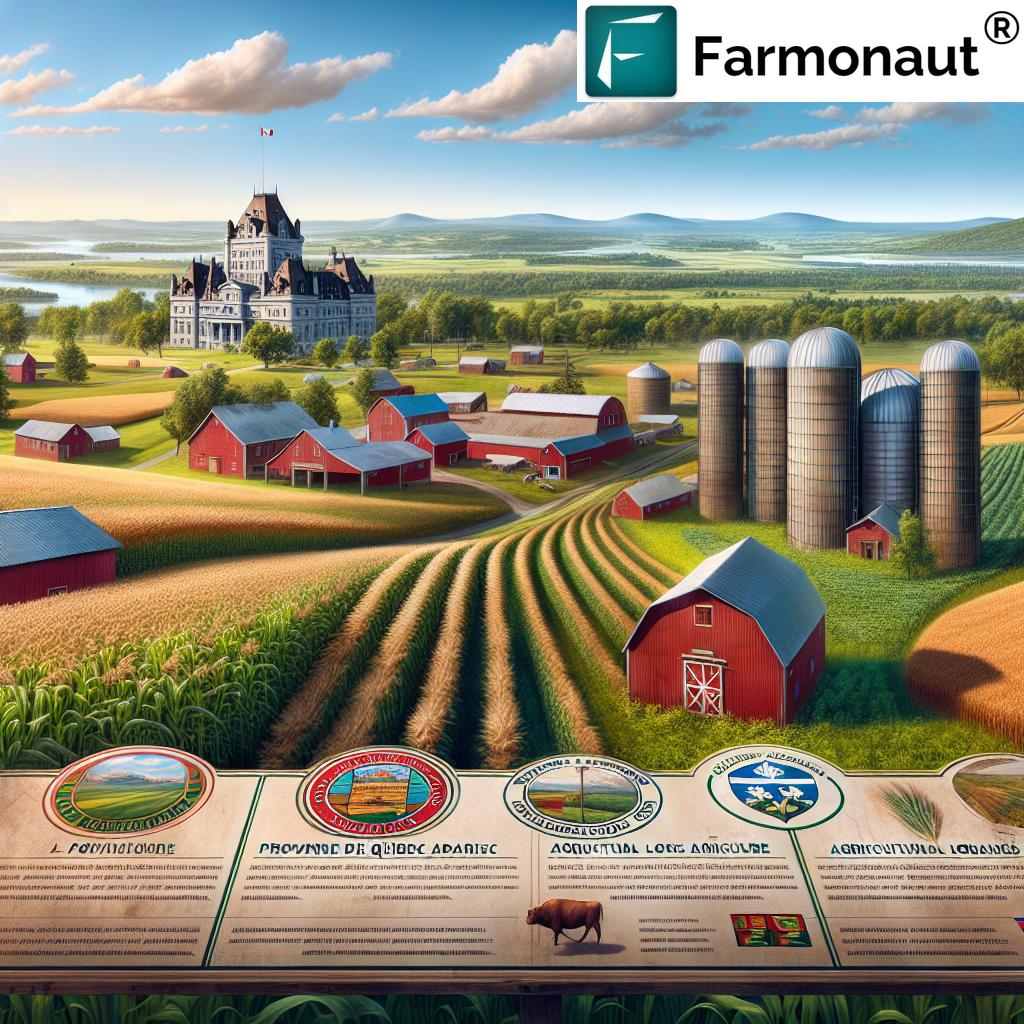Agricultural Machinery ECU Market:
China & Canada 2025
The Agricultural Machinery ECU Market and Its Impact on Global Farming and Forestry Sectors in 2025
“China and Canada will account for over 30% of global agricultural machinery ECU market growth by 2025.”
Table of Contents
- Introduction: Agricultural Machinery ECU Market 2025
- Understanding Agricultural Machinery ECUs and Their Importance
- Global Agricultural Machinery Market Overview in 2025
- Agricultural and Forestry Machinery Market Dynamics
- Key Regional Markets: China & Canada Agricultural Machinery ECU Market
- Comparative Market Overview Table: China vs Canada 2025
- Market Drivers and Trends for Agricultural Machinery ECUs in 2025
- Challenges Facing the Agricultural Machinery ECU Market
- Future Outlook and Innovations
- How Farmonaut Empowers Precision Agriculture & Sustainability
- FAQ: Agricultural Machinery ECU Market, China & Canada 2025
- Conclusion
Introduction: Agricultural Machinery ECU Market 2025
As we move towards 2025, the agricultural machinery ECU market stands at the crossroads of innovation, technology, and sustainability. Across the globe—and most notably in rapidly advancing regions like China and Canada—the integration of sophisticated electronic control units (ECUs) within agricultural and forestry machinery signals a new era for farming efficiency and environmental stewardship.
From sensor-driven data management to AI-powered automation, ECUs are the intelligent heart of the latest tractors, harvesters, and forestry equipment. Their role extends well beyond engine control: ECUs now interface with GPS navigation, real-time machine diagnostics, emission regulation, and more. This article offers a comprehensive analysis of the growth, trends, challenges, and innovations within the agricultural machinery ECU market for 2025, with a particular focus on China and Canada as leaders at the forefront of this sector.
Understanding Agricultural Machinery ECUs and Their Importance
Electronic Control Units (ECUs) are robust embedded systems within modern agricultural and forestry machinery. These architectural components are central to contemporary agriculture machinery market advancement, providing vital control across:
- Engine management (fuel injection, combustion optimization, emission regulation)
- Hydraulics control (precise actuator movement in harvesters, seeders, and forestry equipment)
- GPS navigation & guidance (auto-steering, precision row planting, obstacle avoidance)
- Telemetry & Remote Diagnostics (machine health monitoring, proactive maintenance)
- Integrated data analytics (yield mapping, resource allocation, and environmental compliance tracking)
- Automation & Autonomous decision making (driverless operation, precision control, customizable workflows)
With increasing mechanization, modern ECUs enable precision farming and smart forestry management to optimize fuel utilization, minimize losses, and reduce the environmental footprint of agricultural practices.
A powerful trend propelling global and regional gains is the move toward data-driven agriculture and sustainable food systems, both of which heavily rely on the integration of advanced, connected ECUs.
Global Agricultural Machinery Market Overview in 2025
The global agriculture machinery market is set to surpass USD 150 billion in total value by 2025. This remarkable growth is attributed to:
- Technological advancement—including next-gen ECUs, AI analytics, satellite connectivity, and IoT integration
- Rising food demand alongside shrinking arable land, emphasizing the need for productivity and resource efficiency
- Stringent environmental regulations pushing manufacturers toward compliance with emissions and sustainability benchmarks
- Transition to precision agriculture and smart forestry machinery—enabled by digital control and real-time data processing within machinery
Across global markets, tractors, harvesters, precision seeders, and advanced forestry equipment are increasingly deployed with embedded ECUs for superior control and performance.
For context, the China agricultural machinery market leads by volume, while the Canada agricultural machinery market displays high technology adoption rates per capita—making both high-impact regional markets for ECU integration and innovation.
Agricultural and Forestry Machinery Market Dynamics
The intersection of the agricultural and forestry machinery market is reshaping how crop farming and forest resource management are executed. Forestry applications—though smaller in market size—are particularly capital-intensive, leveraging advanced ECUs to deliver:
- Improved fuel efficiency in challenging forestry terrains
- Advanced safety systems and operator controls
- Automated asset tracking and inventory management
- Real-time analytics, supporting regulatory compliance and sustainable forestry initiatives
This convergence also supports versatile multi-use machinery, such as tractors converted for both crop and forest operations—driven by software-reconfigurable ECUs.
Key point: The fusion of agricultural machinery and forestry equipment capabilities via ECUs optimizes resource allocation and enhances overall machine efficiency.
“By 2025, precision ECUs will power more than 60% of new agricultural machinery in China and Canada.”
Key Regional Markets: China & Canada Agricultural Machinery ECU Market
Let’s explore the unique characteristics and comparative strengths of the China agricultural machinery market and the Canada agricultural machinery market as we head towards 2025.
China Agricultural Machinery Market
China stands out as the world’s largest agricultural machinery market in volume, thanks to unparalleled growth in mechanization and national incentives towards food security. By 2025:
- Precision integration surges: The uptake of embedded ECUs in tractors, harvesters, planters, and irrigation equipment is strongly driven by smart agriculture initiatives.
- IoT and data-driven practices: Chinese manufacturers heavily invest in IoT-enabled ECUs, connecting field machinery to cloud analytics and farm management platforms.
- GPS and autonomous technology: Adoption of GPS navigation and semi-autonomous controls is fast-tracked via domestically produced and imported advanced ECUs.
- Environmental compliance: National regulations require precise emission management, positioning ECUs as key tools for monitoring, reduction, and reporting.
- Foreign technology complement: Integration of foreign high-performance ECUs into domestic brands accelerates the advancement of the sector.
- Sustainability focus: Massive state-backed investments are driving sustainable farming practices, with ECUs providing the backbone for real-time resource management and emission controls.
For Chinese farmers, this translates to higher efficiency, increased autonomy, and access to smart operations via connectivity and cloud data integration.
Canada Agricultural Machinery Market
Canada may have a smaller domestic market but displays leadership in technical adoption, sustainability focus, and agricultural innovation:
- Precision agriculture dominance: Over half of Canadian farms actively use machinery equipped with ECUs for variable rate fertilization, automated steering systems, and yield monitoring.
- Government-backed adoption: Grants and sustainability-driven policies accelerate the spread of smart ECUs in both agricultural and forestry machinery.
- Electrification trends: Canada’s strong climate action agenda encourages electrification and hybridization, where new ECU architectures oversee battery management and energy distribution.
- Emissions and compliance: Precision ECUs facilitate emission tracking and reduction, supporting climate goals and sustainable certifications.
- Forestry integration: ECUs in logging and forest management machines enhance resource monitoring and optimize the use of forest assets.
The result: Canadian agribusinesses operate more efficiently, maintain regulatory compliance, and continually innovate in sustainable agricultural and forestry practices.
Comparative Market Overview Table: China vs Canada 2025
| Region | Estimated ECU Market Size (USD million) | Projected Growth Rate (%) | Primary Applications | Precision Integration Level | Leading Innovation Drivers | Estimated Sustainability Impact |
|---|---|---|---|---|---|---|
| China – Agriculture | $2,000+ | >13% | Tractors, Harvesters, Seeders, Sprayers | Advanced | Smart Agriculture Initiatives, State Incentives, IoT Integration | High |
| China – Forestry | $320+ | ~11% | Harvesters, Skidders, Log Forwarders | Advanced | Government Emission Policy, Fuel Efficiency Needs | Medium–High |
| Canada – Agriculture | $1,150+ | ~9.5% | Tractors, Autonomous Machines, Planters | Highly Advanced | Sustainability Goals, Electrification, Government Grants | High |
| Canada – Forestry | $280+ | ~8% | Harvesters, Log Loaders, Mulchers | Advanced | Carbon Reduction, Forest Management Policy | High |
Note: Estimates based on leading industry forecasts, reflecting ECU market China 2025 and Canada agricultural machinery market dynamics, regulatory drivers, and adoption rates for both the agriculture and forestry sectors.
Market Drivers and Trends for Agricultural Machinery ECUs in 2025
What’s powering ECU adoption in China, Canada, and globally?
- Precision Agriculture Boom: Increasing demand for precision farming relies on sophisticated ECUs to manage sensors, variable-rate implements, and data-rich farm operations. Farmers benefit from higher outputs, reduced input waste, and smarter resource decisions.
- Sustainability & Emission Regulations: As governments enact stricter emissions and environmental standards, ECUs are responsible for fuel management, emissions tracking, and compliance reporting. This is especially critical for manufacturers in China and Canada, where sustainability is at the center of national agricultural policy.
- Automation & Autonomous Machinery: Advanced ECUs are a prerequisite for self-driving tractors, AI-guided harvesters, and robotic forestry equipment—driven by algorithms capable of decision-making, navigation, and remote control.
- Electrification of Machinery: The growing shift towards electric and hybrid machinery depends on new-generation ECUs for managing battery health, energy distribution, and machine diagnostics, aligning especially well with Canadian sustainability goals.
- Connectivity & Data Integration: Through 4G/5G and IoT, ECUs in both China and Canada enable seamless integration with cloud-based management platforms, predictive maintenance services, and large-scale analytics for crop and forest operations.
The fusion of these factors ensures the agricultural machinery ECU market in 2025 is more interconnected, intelligent, and sustainable than ever.
For Canadian or Chinese agribusinesses seeking to optimize fleet logistics and machinery usage, Farmonaut’s Fleet Management Tools provide remote tracking, maintenance alerts, and actionable analytics for resource optimization and reduced operational costs.
Challenges Facing the Agricultural Machinery ECU Market in 2025
While the outlook for the agricultural machinery ECU market is decidedly positive, several barriers could impede uniform global adoption:
- High Initial Investment: The deployment of sophisticated ECU units increases machinery costs, which can be a challenge for smaller farms and developing economies.
- Skill Gap and Complexity: Managing, repairing, and customizing modern ECU-based machinery requires a technically skilled workforce. China is investing in training initiatives, but global disparities remain.
- Cybersecurity Risk: With the rise in IoT connectivity, ECU-driven machines are exposed to hacking, demanding robust security systems to prevent farm and forest data breaches.
- Interoperability Issues: Varying protocols across manufacturers and regions can hinder the seamless integration of multi-brand equipment, limiting full-farm automation and cross-platform analytics.
- Ongoing Maintenance: Sophisticated ECUs require consistent maintenance and updates, creating ongoing cost and logistical hurdles for farmers, foresters, and service technicians.
Addressing these challenges is central to unlocking the full potential of the global agricultural ECU market for all sectors.
Future Outlook and Innovations: Agricultural Machinery ECU Market 2025+
Looking forward, both the china agricultural machinery market and the canada agricultural machinery market are well-positioned to set the pace for global innovation in ECUs:
- AI-Enhanced ECUs: The next wave involves artificial intelligence for adaptive engine mapping, autonomous field maneuvers, and self-learning diagnostics—expanding machine capability in all terrains.
- Edge Computing & Real-Time Analytics: Processing vast volumes of sensor and operational data directly within machinery ECUs, reducing latency, and improving reliability—for instance, in fast-changing weather or soil conditions.
- Modular ECU Designs: Offering scalability and user-specific customization—enabling upgrades in line with technological and regulatory changes.
- Blockchain for Machinery Traceability: ECUs will play an increasing role in in-situ traceability, linking machine usage and maintenance logs to transparent, tamper-proof ledgers that benefit farm supply chains.
Diverging slightly, while Chinese markets will likely double down on mass mechanization and national food security via technology, Canadian agriculture is set to further prioritize sustainability, electrification, and emissions reductions.
Government support, industry initiatives, and ongoing R&D will play a crucial part in ensuring that advancements in ECU technology yield productivity and ecological impacts.
How Farmonaut Empowers Precision Agriculture & Sustainability
At Farmonaut, we are dedicated to democratizing precision agriculture and sustainability for farmers worldwide. Our platform brings together satellite technology, machine learning, blockchain, and AI to deliver actionable insights for crop management, risk mitigation, and resource optimization.
- Satellite-Based Crop Health Monitoring: We offer real-time NDVI, soil moisture, and vegetation analysis to help farmers make data-driven decisions, reduce waste, and maximize yields—making precision farming accessible without the need for expensive hardware investment.
- AI-Driven Advisory: Our Jeevn AI advisory system provides personalized recommendations for irrigation, fertilizer use, and pest management—improving overall efficiency and farm profitability.
- Blockchain-Based Product Traceability: By leveraging blockchain, we can help businesses ensure transparent, end-to-end verification in agricultural supply chains. Learn more about traceability for food, textile, and other sectors via Farmonaut Traceability Solutions.
- Resource & Fleet Management: We empower managers to oversee machinery fleets, track real-time operations, and monitor logistics for both crop and forestry sectors. Optimize asset utilization and reduce operational costs—visit Fleet Management.
- Carbon Footprinting & Sustainability: For Canadian and Chinese agribusiness aiming to meet carbon and environmental targets, Farmonaut’s Carbon Footprinting solution delivers instant insights into carbon emissions and opportunities to reduce environmental impact.
- Large-Scale Management & Plantation Tools: Government, NGOs, and cooperatives benefit from Farmonaut’s Large-Scale Farm Management suite, offering remote mapping, team management, and satellite-based monitoring for massive land parcels.
- Integration & API Access: Developers and businesses can embed our proprietary satellite and weather data directly into their applications and OEM solutions—discover Farmonaut API and access integration documentation at API Developer Docs.
We believe that by putting advanced technology and data-driven management into the hands of farmers and agribusinesses everywhere, we contribute to a smarter, more sustainable, and productive global agriculture ecosystem.
Farmonaut Subscriptions: Make Precision Agriculture Affordable & Scalable
Choose the right subscription to fit your needs—individual farmers, cooperatives, researchers, and enterprises can all access real-time crop health, advanced analytics, and scalable farm management solutions.
FAQ: Agricultural Machinery ECU Market, China & Canada 2025
1. What is an ECU in the context of agriculture and forestry machinery?
An ECU (Electronic Control Unit) is a sophisticated embedded system within agricultural or forestry equipment. It controls, monitors, and automates critical machine functions such as engine performance, hydraulics, emission regulation, GPS navigation, and real-time diagnostics.
2. Why are China and Canada global leaders in the agricultural machinery ECU market for 2025?
China leads in volume due to rapid mechanization, large-scale farming, and strategic investments in smart agriculture technology. Canada excels in precision adoption and sustainability, leveraging advanced ECUs for emissions tracking and electrification, supported by strong government incentives and environmental mandates.
3. How do ECUs contribute to sustainability in farming and forestry?
ECUs help optimize fuel use, manage emissions, enable precise resource application (like fertilizers and water), and support real-time data collection for compliance and ecological monitoring. They are essential in driving sustainable practices across agriculture and forestry sectors.
4. What are the main challenges for widespread adoption of ECUs?
High upfront costs, technical skill requirements, cybersecurity concerns, and the need for interoperability among different machinery and software platforms are major hurdles to maximizing ECU benefits globally.
5. How do ECUs enable autonomous machinery in agriculture?
ECUs act as the “brains” of autonomous tractors and harvesters, processing GPS data, sensors, and onboard analytics to facilitate driverless operations, auto-steering, and intelligent task scheduling.
6. Can Farmonaut integrate with existing ECU-enabled machinery?
Yes—by offering API access and satellite-driven insights, Farmonaut allows farmers, researchers, and businesses to blend real-time remote sensing with on-ground machinery operations for enhanced precision, yield, and sustainability.
Conclusion: ECU Market China & Canada 2025—Powering the Future of Agriculture & Forestry
The rise of the agricultural machinery ECU market marks a transformative era for modern agriculture and forestry as we head into 2025 and beyond. In both China and Canada, ECUs are enabling data-rich, highly efficient, and sustainable farming and forest management practices on a national scale.
With China championing large-scale mechanization and technology integration, and Canada excelling in precision and sustainability goals, these regions are set to shape the next chapter of global agritech evolution. As more ECU-powered systems enter the field, they promise not just increased productivity, but also a more environmentally conscious and data-empowered agricultural future.
For industry stakeholders, farmers, and governments worldwide, continued investment in ECUs, smart data platforms, and sustainable technology will be vital in addressing challenges—from food security to climate change—while unlocking new opportunities for growth, innovation, and planetary stewardship.
Explore how Farmonaut can help transform your agriculture or forestry operations with affordable precision, real-time insights, and advanced management tools—driving the industry forward into 2025 and beyond.













